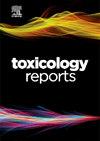有毒金属和生物元素:埃尔比勒省不同地区受试者肝损伤和甲状腺激素紊乱的联合氧化应激效应
Q1 Environmental Science
引用次数: 0
摘要
在伊拉克,特别是在埃尔比勒市和古尔路,由于工业污染物和炼油厂活动,被认为环境不利。本研究对来自农村、城市和工业地区的143名受试者进行了调查。采集受试者血清进行分析。采用电感耦合等离子体质谱法(ICP-MS)测定毒性金属和生物元素,ELISA法测定氧化应激参数。用于估计肝脏测试生物标志物使用Kenza,甲状腺激素使用Cobas测量。同时对他们的关系进行统计分析。结果表明,工业区金属浓度显著升高,其中Fe 599.1 (723.9) μg/L和Mn 7.534 ± 8.793 μg/L的浓度最高。城市受试者体内Cu 4082 (2824) μg/L的中位数明显低于其他地区。氧化应激标志物显示,城市参与者的MDA含量显著高于1917 (1085)pg/mL,而城市和工业参与者的SOD和CP含量显著低于p值(p值分别为0.0001和<;0.0001)。肝脏检查显示城市和工业参与者ALT升高,分别为29.06 ± 1.723 IU/L和21.94 ± 1.162 IU/L。工业参与者的ALP水平显著升高(p值<;0.0001)。研究发现,与农村个体相比,工业工人TSH水平(2.209 ± 0.1032 μIU/L)明显较高,T3水平(1.765 ± 0.0227 nmol/ L)明显较低。Fe与ONOO-呈正相关。TSH (r = 0.2221,r = 0.2452)。Cu与Cp呈正相关(r = 0.2967;p = 0.0068),AST (r = 0.2417;p = 0.0268)和ALB (r = 0.2187; = 0.0457页)。这项研究表明,工业和城市地区有害金属和生物元素水平的增加导致氧化应激,这对公众健康产生重大影响,并导致许多健康问题,包括肝损伤和甲状腺功能障碍。本文章由计算机程序翻译,如有差异,请以英文原文为准。
Toxic metals and bioelements: Combined oxidative stress effects on liver injury and thyroid hormone disruption in subjects from different areas of Erbil province
In Iraq, particularly in Erbil city and Gwer road are deemed environmentally disadvantaged because of industrial pollutants and refinery activities. This study conducted 143 subjects from rural, urban, and industrial areas. The sera of subjects were taken for the analysis. The toxic metals and bioelements were assessed using ICP-MS, the oxidative stress parameters were determined via ELISA. For estimation of liver test biomarkers Kenza was used, and thyroid hormones were measured by Cobas. While their relationships were statistically analyzed. The results indicated that metals concentrations were markedly significantly increased in industrial areas, particularly for Fe 599.1 (723.9) μg/L and Mn 7.534 ± 8.793 μg/L. The median level of Cu 4082 (2824) μg/L in urban subjects is significantly lower than those of other areas. Markers for oxidative stress revealed considerably higher MDA in urban participants 1917 (1085) pg/mL, while SOD and CP exhibited significantly lower level in urban and industrial participants P-value (0.0001 and <0.0001) respectively. The liver tests revealed elevated ALT in urban and industrial participants, 29.06 ± 1.723 IU/L and 21.94 ± 1.162 IU/L, respectively. The ALP levels were significantly elevated in industrial participants (P-value <0.0001). The study found that industrial workers had significantly higher levels of TSH 2.209 ± 0.1032 μIU/L and low levels of T3 1.765 ± 0.0227 nmol/l compared to the rural individuals. Fe had positive correlations with ONOO-. and TSH (r = 0.2221, r = 0.2452). Furthermore, Cu showed positively correlated with Cp (r = 0.2967; p = 0.0068), AST (r = 0.2417; p = 0.0268) and ALB (r = 0.2187; p = 0.0457). This study shows that increased levels of hazardous metals and bioelements in industrial and urban areas cause oxidative stress, which has a significant impact on public health and causes a number of health problems, including liver injury and thyroid dysfunction.
求助全文
通过发布文献求助,成功后即可免费获取论文全文。
去求助
来源期刊

Toxicology Reports
Environmental Science-Health, Toxicology and Mutagenesis
CiteScore
7.60
自引率
0.00%
发文量
228
审稿时长
11 weeks
 求助内容:
求助内容: 应助结果提醒方式:
应助结果提醒方式:


